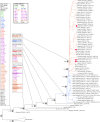How Did Zika Virus Emerge in the Pacific Islands and Latin America?
- PMID: 27729507
- PMCID: PMC5061869
- DOI: 10.1128/mBio.01239-16
How Did Zika Virus Emerge in the Pacific Islands and Latin America?
Erratum in
-
Erratum for Pettersson et al., "How Did Zika Virus Emerge in the Pacific Islands and Latin America?".mBio. 2018 Mar 20;9(2):e00386-18. doi: 10.1128/mBio.00386-18. mBio. 2018. PMID: 29559572 Free PMC article. No abstract available.
Abstract
The unexpected emergence of Zika virus (ZIKV) in the Pacific Islands and Latin America and its association with congenital Zika virus syndrome (CZVS) (which includes microcephaly) and Guillain-Barré syndrome (GBS) have stimulated wide-ranging research. High densities of susceptible Aedes spp., immunologically naive human populations, global population growth with increased urbanization, and escalation of global transportation of humans and commercial goods carrying vectors and ZIKV undoubtedly enhanced the emergence of ZIKV. However, flavivirus mutations accumulate with time, increasing the likelihood that genetic viral differences are determinants of change in viral phenotype. Based on comparative ZIKV complete genome phylogenetic analyses and temporal estimates, we identify amino acid substitutions that may be associated with increased viral epidemicity, CZVS, and GBS. Reverse genetics, vector competence, and seroepidemiological studies will test our hypothesis that these amino acid substitutions are determinants of epidemic and neurotropic ZIKV emergence.
Copyright © 2016 Pettersson et al.
Figures

Comment in
-
Emergence of Epidemic Zika Virus Transmission and Congenital Zika Syndrome: Are Recently Evolved Traits to Blame?mBio. 2017 Jan 10;8(1):e02063-16. doi: 10.1128/mBio.02063-16. mBio. 2017. PMID: 28074023 Free PMC article.
References
-
- Duffy MR, Chen TH, Hancock WT, Powers AM, Kool JL, Lanciotti RS, Pretrick M, Marfel M, Holzbauer S, Dubray C, Guillaumot L, Griggs A, Bel M, Lambert AJ, Laven J, Kosoy O, Panella A, Biggerstaff BJ, Fischer M, Hayes EB. 2009. Zika virus outbreak on Yap Island, Federated States of Micronesia. N Engl J Med 360:2536–2543. doi:10.1056/NEJMoa0805715. - DOI - PubMed
-
- Oehler E, Watrin L, Larre P, Leparc-Goffart I, Lastère S, Valour F, Baudouin L, Mallet H, Musso D, Ghawche F. 2014. Zika virus infection complicated by Guillain-Barré syndrome—case report, French Polynesia, December 2013. Euro Surveill 19:20720. doi:10.2807/1560-7917.ES2014.19.9.20720. - DOI - PubMed
-
- Cauchemez S, Besnard M, Bompard P, Dub T, Guillemette-Artur P, Eyrolle-Guignot D, Salje H, Van Kerkhove MD, Abadie V, Garel C, Fontanet A, Mallet H-P. 2016. Association between Zika virus and microcephaly in French Polynesia, 2013–15: a retrospective study. Lancet 387:2125–2132. doi:10.1016/S0140-6736(16)00651-6. - DOI - PMC - PubMed
-
- Calvet G, Aguiar RS, Melo AS, Sampaio SA, de Filippis I, Fabri A, Araujo ES, de Sequeira PC, de Mendonça MC, de Oliveira L, Tschoeke DA, Schrago CG, Thompson FL, Brasil P, Dos Santos FB, Nogueira RM, Tanuri A, de Filippis AM. 2016. Detection and sequencing of Zika virus from amniotic fluid of fetuses with microcephaly in Brazil: a case study. Lancet Infect Dis 16:653–660. doi:10.1016/S1473-3099(16)00095-5. - DOI - PubMed
Publication types
MeSH terms
LinkOut - more resources
Full Text Sources
Other Literature Sources
Medical
Molecular Biology Databases
Miscellaneous

